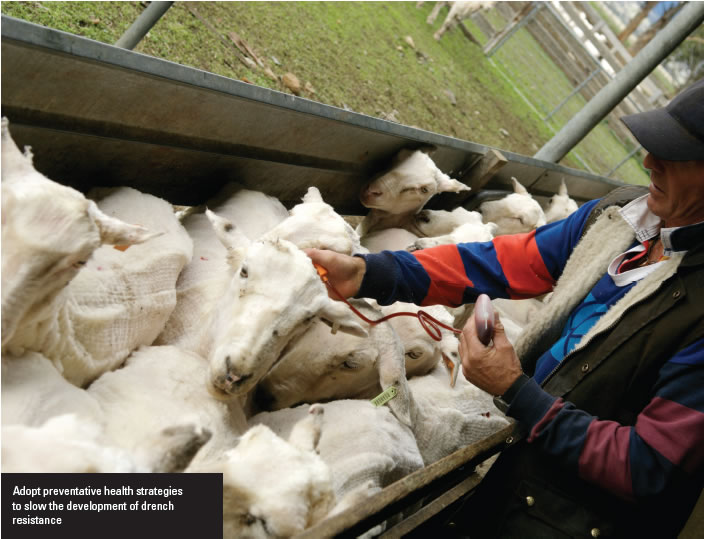|
|
Background
information
Know the important diseases that
can occur on your farm, be able
to recognise symptoms and adopt
preventative strategies rather than
relying on treatments to suppress
disease. Integrate management and
chemical treatments to optimise
production; minimise residues; reduce
animal health costs; and reduce the
development of chemical resistance.
Drench resistance is a major problem
in all areas where gastrointestinal
parasites occur. Whilst it is the
inevitable outcome of using worm
drenches, strategies can be adopted to
slow the development of resistance.
Management changes may reduce
the risk of disease. In such cases, the
underlying program may be changed,
for example, to reduce frequency or
eliminate treatment. Alternatively,
changing flock structure may increase
the risk of parasitic disease, and so
require more intensive monitoring. If
you are unsure, consult your veterinary
practitioner, sheep health consultant,
or State Department of Agriculture/
Primary Industries adviser to determine
the likely disease status of your
property. Local knowledge from other
sheep producers can also help.
|
|
 |
 |
Know and understand the main sheep diseases in your locality
|
 |
Use a preventative health program that integrates chemical control and management to prevent disease
|
 |
Sheep with good nutrition manage worm burdens better |
|
 |
Key decisions, critical actions and benchmarks
Important endemic diseases
The major endemic diseases that require preventative programs include:
- Gastrointestinal parasites, including black scour worm (Trichostrongylus spp), brown stomach worm (Teladorsagia previously known as Ostertagia circumcincta) and barber’s pole worm, Haemonchus contortus, (see tool 11.8 and tool 11.9)
- Liver fluke (see tool 11.10)
- Fly strike (see tool 11.11)
- Clostridial diseases and cheesy gland (see tool 11.12)
- Footrot (see tools 11.13, 11.14, 11.15 and 11.16)
- Lice (see tools 11.13, 11.14, 11.15 and 11.16)
- Ovine Johne’s disease (see tools 11.13, 11.14, 11.15 and 11.16).
Implement a preventative health program
Once the risk of disease is identified, adopt cost-effective preventative programs. For worm control important actions include:
- Strategic treatment timed to reduce the number of drenches required to minimise disease impact
- Management systems to minimise the risk of disease in the highest-risk mobs:
- Grazing management to provide weaner sheep with low-worm-risk
paddocks.
- Rotate sheep and cattle
- Use intensive grazing management to control barber's pole worm
- Make sure weaners and lambing ewes achieve condition score targets to minimise disease risk, and supplement if falling below critical limits for both energy and protein
- Monitor worm egg counts (WEC) as the basis for when to drench
- Monitor drench resistance on your property to ensure only effective drenches are used (see tool 11.9 for guidelines)
- Select sheep for increased resistance to worms (low WEC) and lower dagginess, or purchase rams from studs that can demonstrate progress in this trait without compromising wool and meat quality (see procedure 9.2 in Gain from Genetics)
- Use an integrated parasite management approach.
- Visit www.wormboss.com.au/programs/sheep.php for regional worm recommendations
Trigger points for action
Trigger points are particularly relevant when seasonal conditions are ideal for the development of disease or, alternatively, when drought conditions reduce the necessity for normal strategic treatments. Develop a health monitoring plan that includes trigger points for action, such as a reduction in condition score, WEC above drench threshold, obvious signs of ill health or parasite infestation (e.g. rubbing sheep).
Signposts  |
View
Sheep worms - faecal worm egg counts – visit: www.agric.wa.gov.au/livestock-parasites/sheep-worms-faecal-worm-egg-counts?page=0%2C0
ParaBoss – ParaBoss (http://www.paraboss.com.au/)is designed as an integrated national program providing best practice advice for managing sheep parasites in different environments in Australia. It is the umbrella for the three flagship programs:
- WormBoss
- FlyBoss and
- LiceBoss
Assessing the economic cost of endemic disease on the profitability of Australian beef cattle and sheep producers – to download this technical report click here.
Worm control in southern prime lamb production systems. MLA fact sheet. Click here to download.
Animal Health - Go to the Department of Primary Industry’s website in your state and look under Animal Health.
Apps
The Veterinary Handbook for Sheep, Cattle and Goats: Produced by Livecorp, available for iOS and Android. Allows users to search by species, disease or syndrome to instantly access veterinary advice. Can be used offline.
|

|